
After putting all the top contenders through their paces in this WordPress hosting review, Hostinger came out on top. It strikes the perfect balance between performance, features, and affordability, making it ideal for both beginners and seasoned pros. With fast loading speeds, user-friendly tools, and unbeatable pricing, Hostinger is our go-to pick for building a smooth, reliable WordPress website without breaking the bank.
Of course, Hostinger wasn’t the only host we tested. We compared all the major players — looking at speed, security, customer support, and overall value to see who truly delivers. Some impressed us, some didn’t, and a few surprised us in all the right ways.
Choosing the right host isn’t just a checkbox — it’s the backbone of your WordPress experience. That’s why our hands-on review goes beyond the marketing fluff. We tested each provider in real-world conditions, from simple blogs to traffic-heavy stores, to help you find the host that fits your needs and your budget — no guesswork required.
Top WordPress hosting services for 2025
Looking for the perfect WordPress host? We’ve tested the big names to find out who’s fast, reliable, and actually worth your money. Here are our top five picks that stood out in all the right ways:
- Hostinger: Fast, beginner-friendly, and super affordable — plus, it now has WordPress’s stamp of approval.
- SiteGround: Speed demon alert! Great for growing sites, with daily backups and a free CDN to ensure smooth and secure operations.
- Bluehost: A classic favorite. Easy to use, with solid performance, and backed by years of WordPress credibility.
- DreamHost: Feature-packed and budget-friendly, especially for bloggers and creatives. Great tools, no fluff.
- IONOS: Rock-bottom pricing meets solid performance — especially if you're outside the US. Bonus, stellar customer support.
How to choose the best WordPress hosting in 2025: Step-by-step guide
There are a lot of web hosting tips out there — some helpful, others confusing. We’ve done the testing (and made a few mistakes along the way), so here’s a straightforward cheat sheet to help you choose the right WordPress host:
- Speed and performance: A slow site is a dead site. Look for SSD storage, built-in caching, CDNs, and optimized servers to keep your pages lightning fast, for both visitors and Google.
- Security and backups: You want your site safe from hackers and data loss. Go with a host that includes firewalls, malware scanning, free SSL certificates, and automatic backups you don’t have to think about.
- Uptime and reliability: Downtime doesn’t just cost clicks — it costs calm. Pick a host that guarantees at least 99.9% uptime and has solid infrastructure to back it up.
- Easy-to-use tools: If you’re a beginner, don’t settle for a clunky dashboard. One-click installs, intuitive control panels, and staging sites make your life way easier — especially when you're just getting started.
- Room to grow: Your site might start small, but it won’t stay that way, hopefully. Choose a host that makes it simple to upgrade your plan, handle traffic spikes, or add more websites later on.
- WordPress compatibility: Planning to use WooCommerce, Elementor, or that one must-have SEO plugin? Make sure your host supports everything you need — some don’t play nice with every plugin.
- Good customer support: Tech hiccups happen. When they do, you'll want fast, helpful support—preferably from people who actually know WordPress. Bonus points for 24/7 live chat.
- Transparent pricing: Look beyond the flashy intro deals. Check renewal prices, included features (like email or backups), and whether upgrades cost extra. Nobody likes surprise fees.
The best WordPress host isn’t just fast — it’s the one that grows with you, keeps your site safe, and doesn’t make you pull your hair out. Do a little homework now, save a lot of headaches later.
The main types of WordPress hosting: Which one’s for you?
WordPress hosting comes in more than one flavor — and choosing the right one can make or break your site's performance, budget, and even your sanity. Whether you're starting a beautiful blog or launching a high-traffic business site, here’s a breakdown of the most common hosting types to help you find your perfect match.
Shared WordPress-focused hosting: The starter pack
Shared hosting is like renting a bunk bed in a dorm — it’s affordable, easy to get started with, and works fine when you’re just starting out. Your website shares server space (and resources) with dozens, sometimes hundreds, of others. That keeps costs low, but it can also mean slower speeds if your digital roommates suddenly start hogging all the bandwidth.
Ideal for: New bloggers, small personal websites, or anyone who’s testing the WordPress waters without diving into deep tech territory.
Not great for: Sites expecting spikes in traffic, or anyone who wants more control over performance.
Managed WordPress: VIP treatment for your site
If shared hosting is a dorm room, managed WordPress hosting is a boutique hotel with staff working behind the scenes 24/7. These plans are built specifically for WordPress and come with perks like automatic updates, daily backups, premium security, and a support team that actually knows WordPress.
You don’t have to worry about the tech stuff — focus on your content and let the experts handle the rest. It’s beginner-friendly and powerful enough for growing businesses.
Ideal for: Anyone who wants speed, security, and peace of mind without needing to be a server wizard.
Not great for: Super budget-conscious users or those who prefer to manage every little detail themselves.
VPS WordPress hosting: More power, more control
VPS (Virtual Private Server) hosting is like upgrading to your own apartment. You still share a building, but you’ve got your own walls, your own kitchen, and way more say in how things are run. You get a portion of the server's resources just for your site, which means better performance and more stability than shared hosting.
This is a great middle-ground option for websites that are growing fast and need a bit more muscle to handle the extra traffic.
Ideal for: Medium-sized businesses, fast-growing blogs, or anyone who wants a customizable environment without going full-on dedicated.
Not great for: Beginners or folks who’d rather not deal with technical configurations.
Cloud hosting: Scalable and stress-free
Cloud hosting spreads your website across a network of connected servers, which means better reliability and easy scaling. Traffic spike? No problem. The cloud can handle it. This setup is flexible, fast, and usually billed based on usage, which can be a blessing (or a curse) depending on how much traffic you're pulling in.
Ideal for: Sites with fluctuating traffic, e-commerce stores, or anyone who wants performance and flexibility.
Not great for: Small personal websites or those who want predictable, low monthly pricing.
Dedicated hosting: The top-shelf option
Dedicated hosting gives you an entire server to yourself. No neighbors, no resource sharing, just you and all the horsepower you could ever need. It’s the fastest, most customizable, and most secure option out there — but it’s also the priciest and typically requires more technical know-how (or a managed service).
Ideal for: Large businesses, enterprise-level sites, or high-traffic WordPress projects where performance is non-negotiable.
Not great for: Beginners, hobby sites, or anyone watching their hosting budget closely.
Best WordPress hosting in 2025: Our top picks, tested and trusted
From lightning-fast load times to helpful support and everything in between, these are our favorite WordPress hosts of 2025, handpicked, tested, and ready for action.
1. Hostinger: Best WordPress hosting service overall

| WordPress plans pricing | $11.99 – 47.99/month |
| WordPress features | 1-click WordPress install, cache manager, fully managed maintenance, auto-updates, vulnerabilities scanner, staging tool, and free AI website builder |
| Money-back guarantee | 30 days |
| Uptime guarantee | 99.99% |
| Best deal | 79% off coupon > |
If you're looking for a WordPress host that balances price, performance, and ease of use, Hostinger is hard to beat. We’ve tested numerous WordPress hosting providers over the years, and Hostinger made a strong impression from the moment we clicked “Sign Up.”
What stood out most? It’s beginner-friendly without feeling stripped-down, and it offers a surprisingly robust toolbox for more experienced users too. Whether you’re starting your first blog or managing multiple client sites, Hostinger feels like a reliable co-pilot – and it won’t empty your wallet.
Hostinger pros and cons
Before you jump in, here’s the real scoop on what Hostinger does best — and where it could be better:
+ Pros
- Beginner-friendly site builder across all plans
- Budget-friendly pricing
- Multiple types of web hosting
- AI-powered troubleshooter for WordPress sites
- Free domain for one year
- Free business email included
- Free automatic site migration
- Unlimited free SSL certificates
- User-friendly control panel called hPanel
- Servers across four continents and nine countries
- Free weekly and daily backups
- LiteSpeed servers with built-in cache engine for lightning-fast performance
- Large discounts for long-term plans
- 30-day money-back guarantee
- 99.9% uptime guarantee
– Cons
- hPanel can be slow at times
- No dedicated or unmanaged hosting
- No phone support
- Email accounts share limited storage space
- Higher renewal rates
Features: What you get with Hostinger
Hostinger packs in features that rival far more expensive services. For starters, we got a free domain for the first year, unlimited SSL certificates, and 100 GB of SSD storage right out of the gate – not bad for under $3 a month.
We especially liked the LiteSpeed web servers, which make websites load faster and run more smoothly. Our test site loaded in under a second on average – that’s not just fast, that’s blink-and-you’ll-miss-it fast. There’s also built-in caching to speed things up even further, and AI tools that actually helped us improve performance without diving into code.
Security-wise, Hostinger brings the goods. You’ll get DDoS protection, a malware scanner, a web application firewall, and automatic backups (weekly on lower plans, daily on higher ones). While other hosts charge extra for some of this, Hostinger includes most of it upfront – a huge plus in our book.
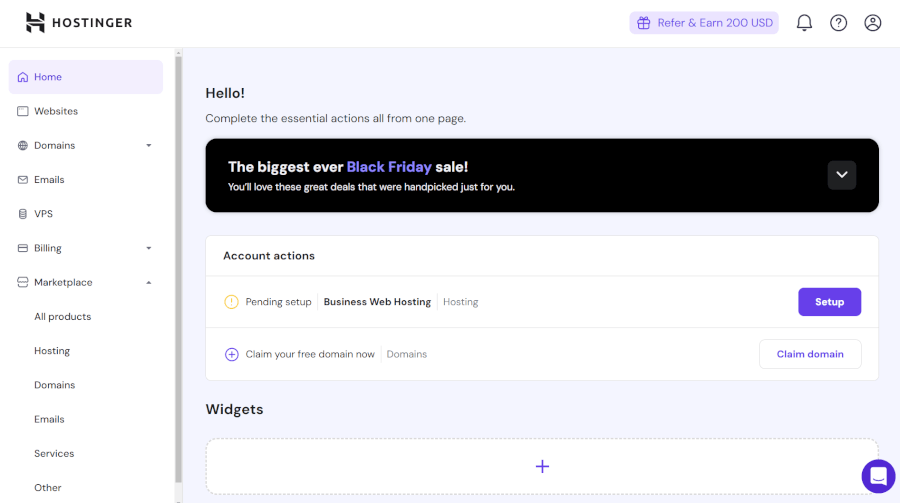
And let’s talk about the hPanel, Hostinger’s custom-built control panel. We were skeptical at first, but honestly, it’s easier to use than cPanel and more visually streamlined. Everything – from domain setup to plugin management – is just a few clicks away.
Pricing: What you’re paying for
Hostinger’s WordPress entry-level plans start at just $2.99/month, and that price-to-feature ratio is tough to beat. That includes support for 100 websites, weekly backups, and a free domain for one year – more than enough to get most people off to a solid start.
Just be aware, renewal prices jump up after your first term (usually more than double), so if you're in it for the long haul, it pays to lock in a longer subscription upfront. Still, even at regular rates, Hostinger offers strong value compared to most competitors.
Ease of use and performance: Testing Hostinger
We kicked things off by setting up a test WordPress site using Hostinger’s one-click installer, and right from the start, it felt effortless. The onboarding process was surprisingly smooth, walking us through each step with helpful prompts — and even tossing in AI-generated content suggestions to get us going faster. It’s beginner-friendly without feeling watered down.
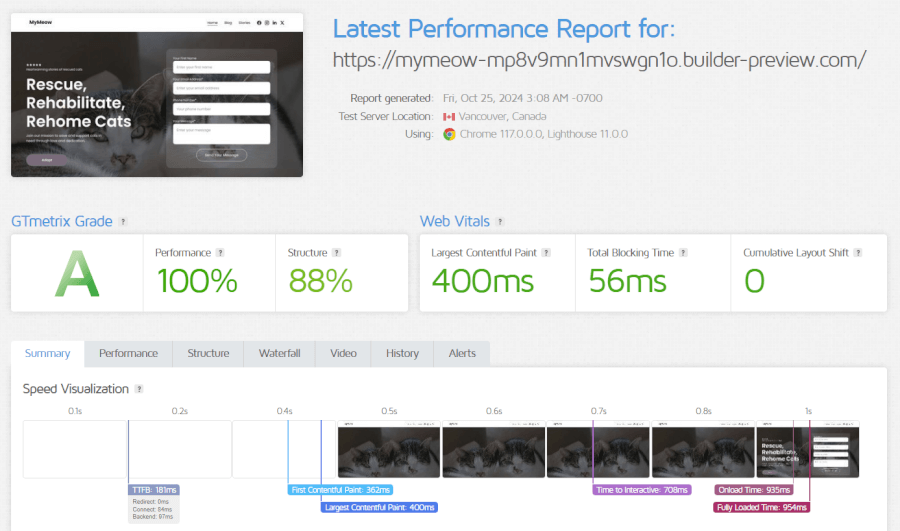
Once our site was live, we ran our usual round of speed and stress tests. Hostinger clocked in with an average load time of just 0.9 seconds, which blew past the average load time for most websites. We even earned a GTmetrix grade A, thanks in large part to Hostinger’s use of LiteSpeed servers, NVMe SSD storage, and built-in Cloudflare CDN support. This combo gives your site a real performance edge — even under moderate traffic, we didn’t see a single hiccup.
We’ve also been closely monitoring uptime, and so far, Hostinger has delivered on its 99.9% uptime guarantee with zero downtime during our test period. That level of consistency is rare at this price point — and the fact that they back their uptime promise with a service credit if they fall short adds even more trust.

Hostinger’s AI site builder takes the stress out of creating a WordPress site. Just tell it your brand and site type, and it’ll generate a polished layout in no time. With over 150 templates to choose from, customizing your site is a snap. Plus, it even suggests handy plugins based on your site’s needs. It’s the perfect mix of speed, style, and ease.
And if anything ever felt off? 24/7 live chat support was just a click away. We tested it a few times, and each time we got helpful answers in under five minutes.
Is Hostinger the right choice for you?
Whether you're just starting with WordPress or simply want a reliable, budget-friendly host, Hostinger is an easy recommendation. It's especially great for bloggers, freelancers, small businesses, and anyone juggling multiple sites without wanting to overspend.
Even if you’re not new to the game, Hostinger’s performance, support, and ease of use make it a strong pick for most users. While advanced features like staging environments, daily backups, or a built-in CDN are reserved for higher-tier plans, the overall value here is hard to beat. For the majority, Hostinger hits that perfect balance between price and performance.
2. SiteGround: Polished, powerful, and performance-first WordPress hosting

| WordPress plans pricing | $14.99 – $49.99/month |
| WordPress features | WordPress staging, caching, Speed Optimizer plugin, Ultrafast PHP, WooCommerce enabled, and daily backups |
| Money-back guarantee | 30 days |
| Uptime guarantee | 99.9% |
| Best deal | 75% off coupon > |
SiteGround has long been the kind of host that doesn’t just do the job, it brings a little flair to the process. Perfect for WordPress fans who want peace of mind and performance without having to study server specs like it's finals week. With a strong reputation in the WordPress community and a bit of birthday cake this year — they just turned 20, SiteGround has become a crowd favorite for good reason.
This isn’t your typical bargain bin host. Sure, they offer solid promos upfront, but behind the price tag is a web host that feels more like a partner than a product. From eco-friendly infrastructure to WordPress contributions, SiteGround is helping shape the future of the web.
SiteGround pros and cons
There’s plenty to love about SiteGround, but a few quirks too. Here’s our take on the pros and cons:
+ Pros
- Lightning-fast load times
- Data centers across four continents
- Free SSL on all plans
- Free Weebly website builder for beginners
- User-friendly custom control panel
- Flexible server location options
- Stellar 24/7 customer support
- Some superb add-ons (for an extra fee)
- 99.9% uptime guarantee
- 30-day money-back guarantee
– Cons
- Limited storage on basic plans
- No VPS or dedicated hosting
- Price hikes on renewal
Features: What you get with SiteGround
To start, SiteGround’s WordPress hosting includes daily backups, free SSL, email hosting, and unlimited databases — even on the base plan. They also throw in a site migration plugin that works like magic for anyone switching from other hosting providers. And if you want to skip the DIY? Just let their pros handle it.
But the real beauty? Their in-house performance stack. Think Ultrafast PHP, SSD storage, a built-in CDN, and custom MySQL tweaks that trim your load times like a good barber trims split ends. Translation: fast, reliable websites that don’t leave your visitors hanging.
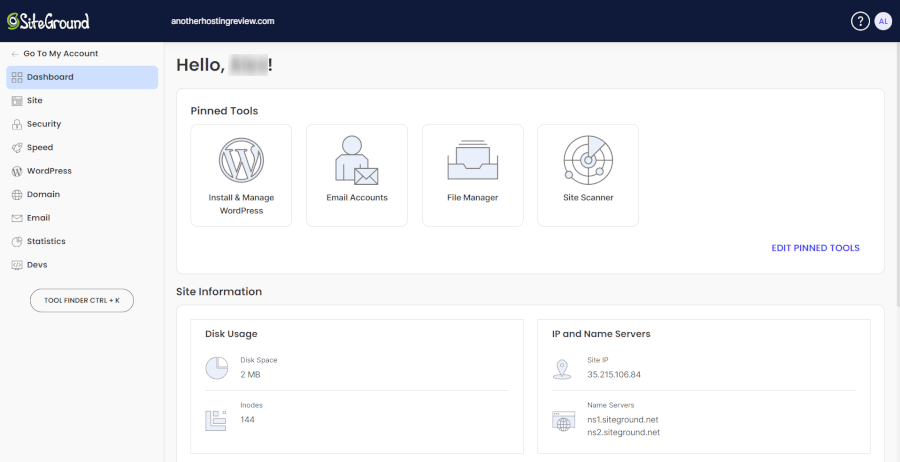
Add to that their user-friendly Site Tools control panel — which ditches the “outdated” cPanel in favor of a sleeker experience — and you’ve got hosting that’s as intuitive as it is powerful. Bonus points for their Weebly drag-and-drop builder and one-click installs for everything from WordPress to PrestaShop and Joomla.
Oh, and did we mention they're eco-conscious? Yep, their servers run on 100% renewable energy. It’s like giving your website a Tesla.
Pricing: What you’re paying for
SiteGround’s pricing isn’t rock-bottom, but what you get in return is worth it. Their entry-level StartUp plan comes in at $14.99/month (when you go with a longer-term deal), which is a steal considering it includes all the basics — and then some. “GrowBig” and “GoGeek” bump up the features and resources for users ready to scale or flex their developer muscles.
That said, be prepared for renewal sticker shock. Once your initial term is up, prices jump to their standard rates, which aren’t exactly gentle. If you love what SiteGround offers, consider locking in a longer plan upfront or reaching out to their support — sometimes they’ll cut you a break on the renewal.
Ease of use and performance: Testing SiteGround
Setting up your website on SiteGround is refreshingly smooth. Whether you're launching your first blog or migrating a WooCommerce store, the guided setup walks you through everything—domain setup, app install, SSL activation, even email configuration. It’s beginner-friendly but doesn’t dumb anything down.
We especially liked their custom Site Tools dashboard. It replaces the tired old cPanel with big icons, intuitive menus, and fast access to powerful features. You can customize the layout, pin your favorite tools, and manage everything from backups to staging environments like a pro. It even integrates smoothly with your chosen site builder — whether you’re using WordPress or Weebly — making it easier to tweak, launch, and manage your site from one sleek control panel.
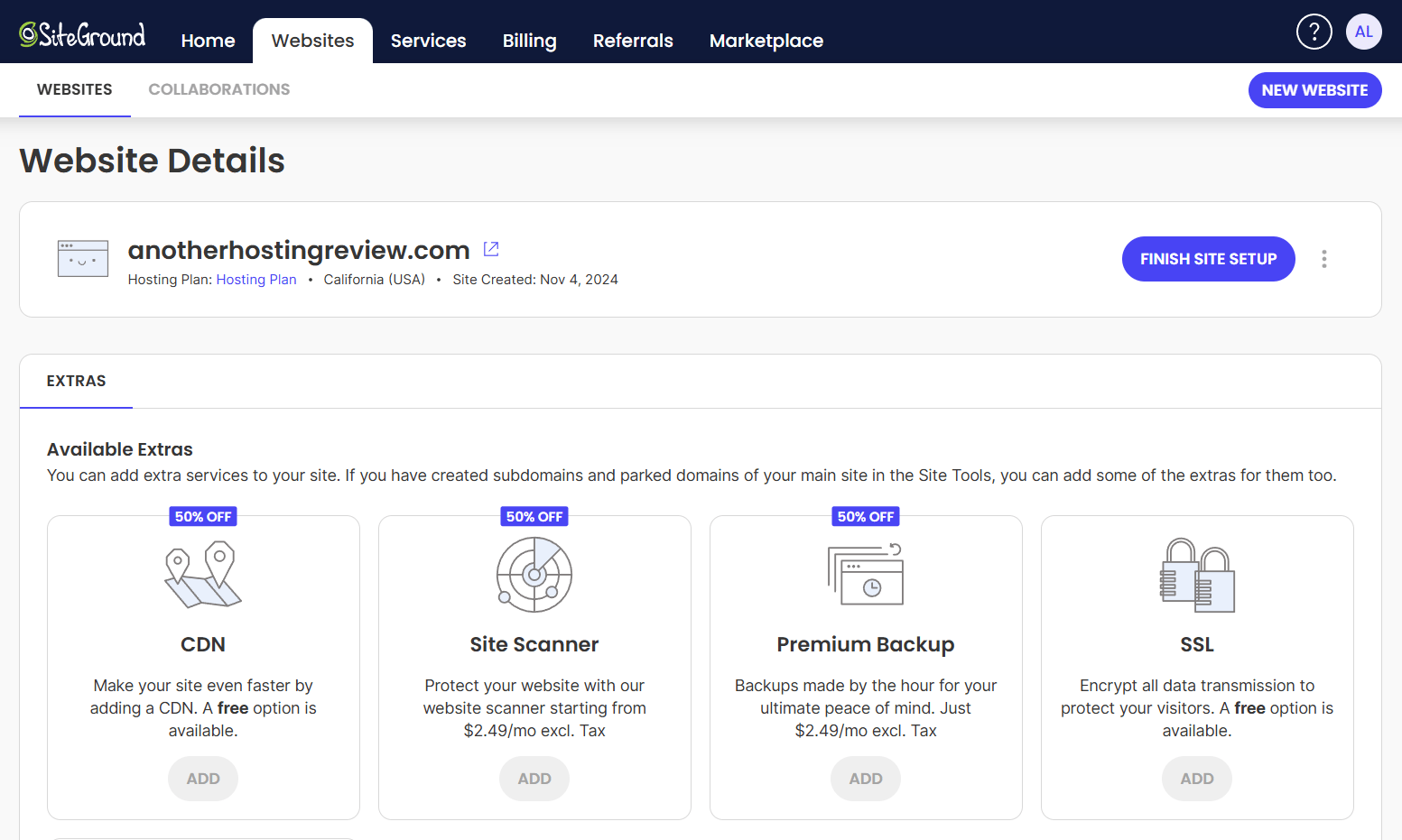
Performance-wise, SiteGround is rock solid. During our tests, we saw no downtime (shoutout to their 99.9% uptime guarantee), and our test site loaded in under a second on GTmetrix — earning an A-grade and a perfect 100% performance score.
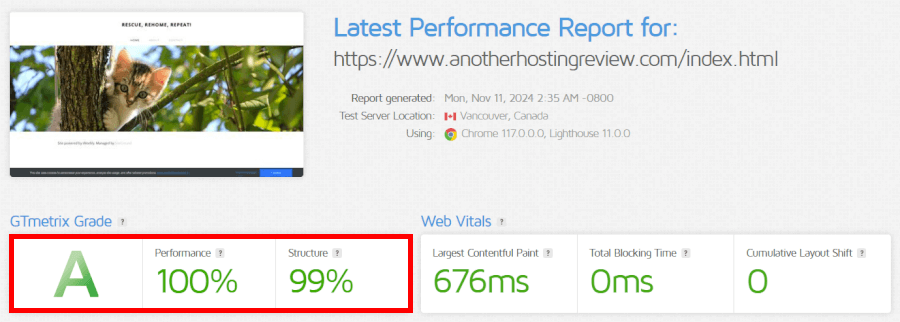
With data centers spread across four continents, you can choose a location that brings your site closer to your audience, and SiteGround handles the rest.
And for those who care about security, SiteGround is all-in. Free SSL, daily backups, account isolation, spam protection — it’s the kind of hosting that lets you sleep at night.
Is SiteGround the right choice for you?
If you’re looking for WordPress hosting that’s fast, secure, and doesn’t make you jump through flaming hoops to get started, SiteGround is an excellent pick. It’s especially ideal for creators, small businesses, and devs who want reliable performance with minimal fuss.
The pricing might not be the lowest on the block, and you’ll need to budget for the renewal rates, but the features, support, and peace of mind you get in return are worth every penny.
3. Bluehost: A perfect pick for WordPress beginners and budget-focused sites

| WordPress plans pricing | $11.99 – $21.99/month |
| WordPress features | WordPress plugin collection, updates, free domain and SSL, WordPress staging tools |
| Money-back guarantee | 30 days |
| Uptime guarantee | Not specified |
| Best deal | 75% off coupon > |
Bluehost is one of those names that’s been around forever in the hosting world, and there’s a reason for that. It’s beginner-friendly, affordable up front, and tightly integrated with WordPress. Whether you’re launching your first blog or building a basic business site, Bluehost sets you up with a straightforward interface and all the essentials to hit the ground running.
But while Bluehost keeps things simple, it doesn’t skimp on helpful features. You’ll find free domain registration, a drag-and-drop AI builder, and quick access to WordPress through a 1-click install. Just be aware: some extras come at a cost, and renewal pricing can jump quite a bit after your first term. Still, for getting started, it’s a solid and budget-conscious pick.
Bluehost pros and cons
Curious if Bluehost is the right fit for your WordPress website? Let’s explore the pros and cons before making a decision:
+ Pros
- Cheap starting price at $1.99/month
- Free domain registration for the first year
- Free SSL certificate
- User-friendly and sleek interface
- Highly reliable and fast servers
- Convenient website staging area
- Easy-to-use AI website builder
- 1-click WordPress install and recommended by WordPress to boot
- 30-day money-back policy
– Cons
- Renewal rates can be significantly higher
- Basic entry-level plans
- Potential hidden fees
- No uptime guarantee
Features: What you get with Bluehost
One of Bluehost’s biggest strengths is its flexibility. Whether you’re working on a personal blog or hosting multiple client websites, you’ll find a plan that fits. Bluehost supports everything from shared hosting to VPS, dedicated servers, and even fully managed WordPress hosting. And no matter which you choose, you’ll get a solid foundation that includes NVMe storage, a free CDN, and a free SSL certificate.
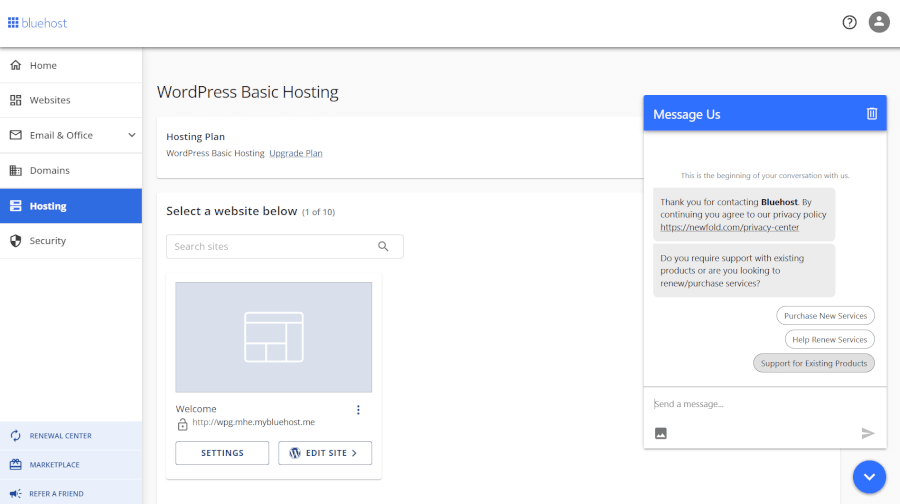
Managing your site is refreshingly easy with Bluehost’s dashboard. You can install WordPress with a click, set up email accounts, and use handy shortcuts to jump straight into creating blog posts or customizing your site.

If you're feeling stuck, the built-in AI site builder, WonderSuite, helps you launch a ready-to-go WordPress website based on a few quick prompts. We gave it a spin and were impressed by how intuitive it felt — even if one of the three suggested designs missed the mark.
Performance-wise, Bluehost uses Cloudflare CDN to help your content load quickly, no matter where your audience is. And while automatic backups and malware scanning require a paid upgrade, they’re nice to have if you want that extra peace of mind. Bluehost also lets you host multiple sites (up to 100, depending on the plan), which makes it easy to scale up as your ideas grow.
We also liked the inclusion of free email hosting, giving your domain that extra professional polish. From setup to customization, Bluehost keeps things beginner-friendly while offering just enough flexibility to grow with you.
Pricing: What you’re paying for
Bluehost’s “Basic” plan is a steal at just $2.95/month for the first year. You get all the essentials like a free domain for the first year, free SSL, and unmetered bandwidth — perfect for a simple website or blog. But don’t forget, it renews at $11.99/month, so keep an eye on those future prices.
For the shop owners out there, the “eCommerce Premium” plan is a solid choice, starting at $9.95/month for the first year. It's packed with everything you need to run an online store, including built-in e-commerce tools. After the first year, the price bumps up to $21.99/month.
Just a heads-up — extra features like automatic backups, domain privacy, or a dedicated IP come with extra fees, so it's worth doing the math before you dive in. But hey, if you’re looking to launch your WordPress site without breaking the bank, Bluehost’s got your back!
Ease of use and performance: Testing Bluehost
Right from the signup process, Bluehost delivers a smooth experience. Signing up is simple enough for complete beginners and includes clear instructions to register a new domain or connect an existing one. Once you’re in, the dashboard is clean, responsive, and refreshingly uncluttered — great for first-time users who want to build their site without diving into technical stuff.
We tested Bluehost by installing WordPress, uploading some demo content, and tracking site performance. GTmetrix awarded our test site an A grade with a 93% performance score, and it loaded in just over 2 seconds — quicker than the average and perfectly fast for a basic site or small business.
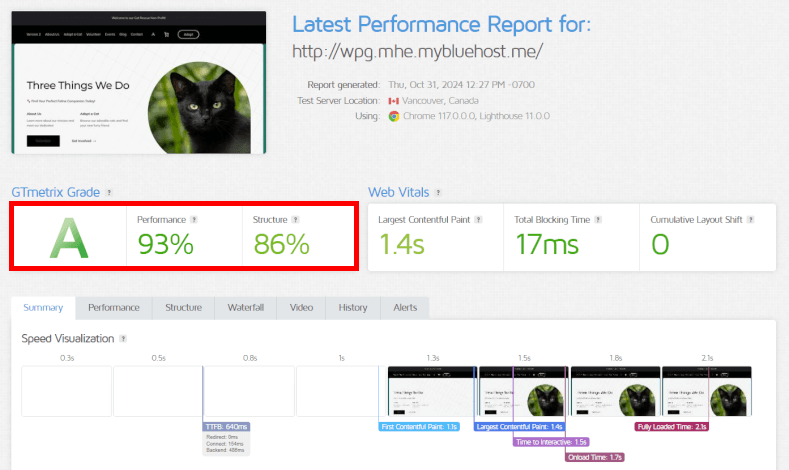
For uptime, we used UptimeRobot to monitor our Bluehost site over a few weeks. The results? A flawless 100% uptime during our testing period. While some users have reported occasional dips in uptime, our experience was smooth throughout.
And when it comes to building a site, Bluehost’s AI-powered WonderSuite makes it seriously easy. You just describe what kind of site you want — like a blog or online store — and the AI generates a few ready-made designs. You can customize everything with WordPress tools, including drag-and-drop editing and real-time previews. It’s a fast, fun way to get a site up and running with minimal effort.
Is Bluehost the right choice for you?
If you’re launching your first WordPress website or looking for a reliable, easy-to-use host without blowing your budget, Bluehost is a strong contender. The beginner-friendly interface, free domain, and helpful AI tools make it ideal for getting started quickly, especially if you’re not super tech-savvy.
Just be sure to review the full cost of ownership before committing. Some useful features cost extra, and renewal rates aren’t as low as the starting price. Still, if you want a simple, flexible web hosting solution that plays nicely with WordPress, Bluehost delivers a solid balance of value and performance.
4. DreamHost: A splendid choice for speed and sustainability

| WordPress plans pricing | $5.99 – $74.99/month |
| WordPress features | WordPress installer, automated migration, plugins, AI site builder, 1-click staging, and daily backups |
| Money-back guarantee | 97 days |
| Uptime guarantee | 100% |
| Best deal | 67% off coupon > |
If you're looking for a budget-friendly web hosting provider that doesn’t skimp on speed or sustainability, DreamHost deserves a closer look. It’s been around for more than two decades, quietly winning over users with its clean energy practices, transparent pricing, and customer-first policies.
DreamHost offers everything from basic shared hosting to managed WordPress, VPS, and dedicated plans — so whether you’re a first-time site owner or scaling up, there’s a plan that fits. It’s not the flashiest host on the market, but what it lacks in flair, it makes up for in reliability and performance.
DreamHost pros and cons
DreamHost on your radar? Let’s explore its pros and cons to determine if it’s the right fit for you:
+ Pros
- Pocket-friendly plans
- Solid site load speed and uptime
- User-friendly control panel for beginners
- 97-day money-back guarantee for shared hosting
- Strong security features
- Extensive domain-management tools
- Wide variety of hosting options to choose from
- Unlimited data transfers per month
- Generous money-back guarantee
- Free automated WordPress migrations
- Carbon-neutral hosting
– Cons
- Data centers only in the US
- No phone support
- No free email with the cheapest shared hosting
- No CDN included for international users
Features: What you get with DreamHost
One of DreamHost’s biggest selling points is its no-fuss, everything-you-need approach. Every plan includes unlimited bandwidth, free SSL certificates, and a 100% uptime guarantee. And when DreamHost says 100%, they mean it — if your site goes down, they’ll compensate you accordingly.
While you won’t find a free version, the free domain on annual plans helps soften the blow — and it’s obvious that security isn’t an afterthought here. You’ll find built-in protections like malware removal (via the optional DreamShield add-on), firewalls, and free HTTPS across the board.
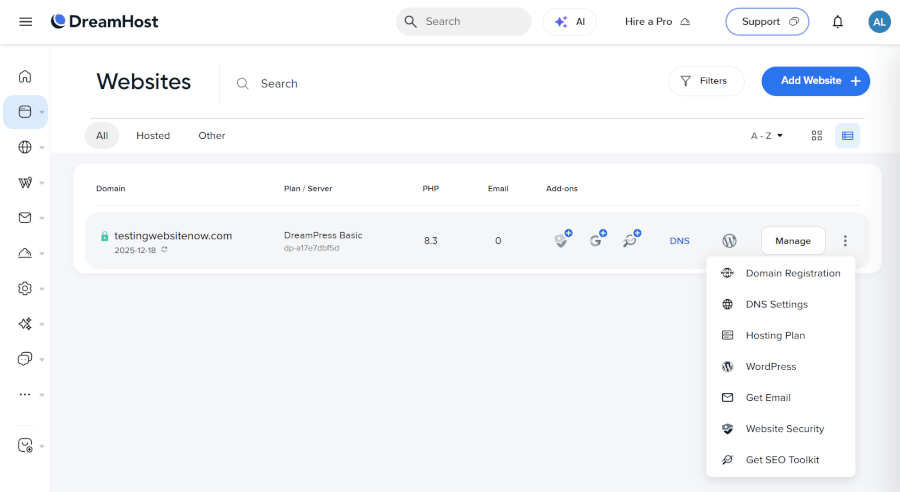
Their control panel deserves a shout-out too. It’s not cPanel — it’s a custom interface that’s surprisingly clean and user-friendly. Beginners can easily manage their domains, email, and sites without digging through complex menus, while more advanced users still get the flexibility to dive into code or use FTP.
If you’re into WordPress, DreamHost rolls out the red carpet. One-click installs, automatic updates, and even free automated site migrations are all included. Plus, their AI-powered WordPress website builder can generate a site for you, complete with design and content — a huge timesaver if you’re starting from scratch.
And did we mention DreamHost is eco-friendly? They power their data centers with renewable energy and embrace paperless billing and energy-efficient infrastructure. It's web hosting you can feel good about.
Pricing: What you’re paying for
DreamHost’s “WordPress Business” plan comes in at just $2.59/month if you commit to three years, making it one of the most affordable long-term options out there. That entry-level price gets you one website, unlimited traffic, and a free SSL certificate, but not email.
They also offer a 97-day money-back guarantee on shared hosting — far more generous than the typical 30-day window. It gives you plenty of time to test the waters, whether you're setting up a portfolio, blog, or business site.
“DreamPress” (managed WordPress hosting) starts at $16.95/month and includes extras like built-in caching, faster speeds, and priority support. It’s a bit pricier, but it’s optimized for performance-heavy WordPress sites.
Ease of use and performance: Testing DreamHost
Getting started with DreamHost is refreshingly easy. From sign-up to domain connection, the process is smooth and beginner-friendly. Even DNS updates — usually a headache — are clearly explained. If you're using WordPress, you can have it pre-installed during setup or add it with a single click later.
Once inside the DreamHost dashboard, you’ll find a well-organized control panel that doesn’t overwhelm. It won’t win design awards, but it’s functional and intuitive, especially for new users. You can manage everything from SSL to email in just a few clicks, and the “Grid View” gives a visual snapshot of all your websites.
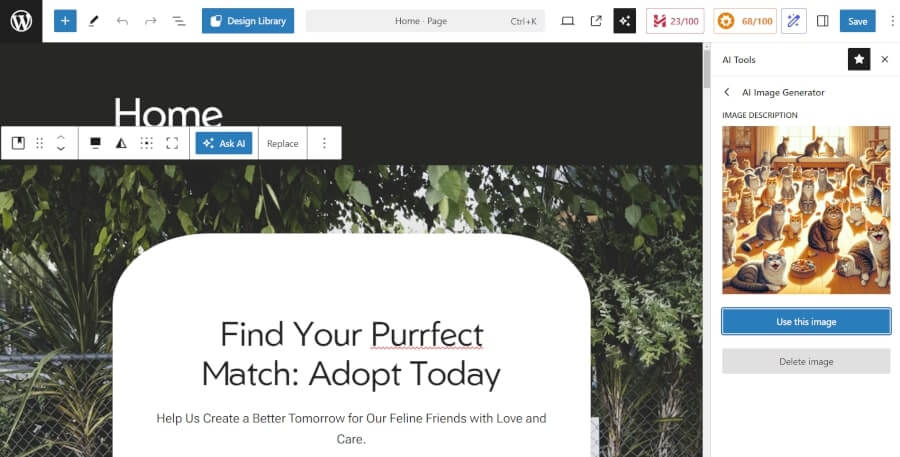
The Liftoff AI website builder is a newer addition, and we were pleasantly surprised. It asks you a few questions and then builds a complete WordPress site tailored to your needs — layout, text, and all. From there, you can tweak it using WordPress’s familiar editor, giving you the best of both automation and customization.
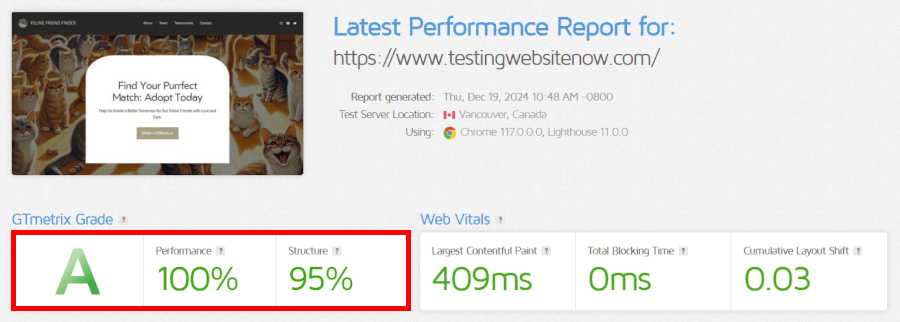
Performance-wise, DreamHost impressed us. Our test site loaded in just over a second and scored a GTmetrix A (100%), thanks to SSD-powered infrastructure. And the 100% uptime? Not just a marketing line — we confirmed it with UptimeRobot monitoring, and DreamHost didn’t miss a beat.
That said, one caveat — All DreamHost data centers are based in the US. If your audience is global, you might notice slower loading speeds in other regions. A third-party CDN can help with that, but it’s not included by default.
Is DreamHost the right choice for you?
If you’re after affordable hosting that combines strong performance, user-friendliness, and a side of sustainability, DreamHost is a top contender. It’s especially appealing for US-based sites, WordPress users, and anyone who appreciates a long money-back window.
It’s not perfect — the lack of phone support and international data centers may be deal-breakers for some — but overall, DreamHost delivers great value for the price. Whether you're launching your first site or managing a growing one, it’s a hosting provider you can count on.
5. IONOS: Best for value-packed hosting with global reach

| WordPress plans pricing | $5 – $15/month |
| WordPress features | WordPress installer, automatic updates, staging tools, caching plugin, AI website creation, and Jetpack backups |
| Money-back guarantee | 30 days |
| Uptime guarantee | 99.99% |
| Best deal | 91% off coupon > |
With over 30 years of experience and data centers across Europe and the US, it’s no surprise IONOS has become a go-to for small businesses, freelancers, and anyone building a website on a budget.
But this isn’t just a bargain-bin hosting provider. From managed WordPress-focused hosting to full-blown dedicated servers, IONOS offers a little something for everyone — all wrapped up in a clean, user-friendly dashboard. Sure, there are a few quirks along the way, but overall, IONOS punches above its weight when it comes to value.
IONOS pros and cons
Time to break down what’s hot and what’s not with IONOS — let’s get into the pros and cons:
+ Pros
- Wide range of hosting options
- Free domain and SSL on all plans
- Robust full-stack security features
- 99.99% uptime guarantee
- Blazing-fast site load speeds
- Website builder included in all plans
- Affordable pricing for all budgets
- Scalable RAM options for shared hosting
- Support for both Linux and Windows servers
– Cons
- Hidden fees lurking in the fine print
- Entry plans come with fewer resources
- No free site migration — you’re on your own
- High renewal fees after the initial discounted period
- Shared hosting plans only come with one email account
Features: What you get with IONOS
Whether you're spinning up your first website or scaling up a high-traffic project, IONOS brings a buffet of features to the table. Their hosting plans range from shared hosting for simple sites to robust VPS and dedicated options for more demanding needs. There’s even a tailored WordPress hosting plan with built-in tools to make site setup and management a breeze.
One standout feature? The global server network. With mirrored data centers in the US, UK, Germany, and Spain, your site’s visitors get snappy load times no matter where they’re browsing from. Throw in Cloudflare CDN integration and SSD storage, and you’re looking at a solid foundation for fast, reliable performance.
Security-wise, IONOS goes all-in. Every plan includes a free Wildcard SSL certificate, daily backups, and DDoS protection. And if you're the type who likes everything in one place, you’ll appreciate that IONOS also throws in a free domain, a simple website builder, and email hosting (though shared plans limit you to one email account).

Perhaps our favorite feature? The custom control panel. While it’s not the classic cPanel interface some folks are used to, we found it refreshingly simple. It’s clean, intuitive, and doesn’t bury you in unnecessary options. For beginners especially, it takes a lot of the fear out of hosting.
Pricing: What you’re paying for
IONOS offers a fantastic deal for WordPress hosting, especially if you're starting small. For just $5/month with a 1-year commitment, you can kick off your WordPress site. Even better, they’re offering a whole year for free if you sign up for a 36-month plan! After the initial term, the price increases to $ 6 per month, which is still quite reasonable for what you get. Just keep in mind the renewal prices before finalizing your purchase!
Unlike some competitors, IONOS doesn’t sneak in hidden fees or vague pricing. The final cost is clearly displayed before you pay, and there’s no bait-and-switch when it comes to renewal rates. However, features like site migration or extra email accounts may cost more — so check the fine print if you’re on a tight budget.
Ease of use and performance: Testing IONOS
Getting started with IONOS was mostly smooth sailing. Account setup is fairly straightforward — you’ll pick a plan, choose a domain, and decide whether to tack on any optional extras. That said, expect a few upsell prompts along the way. While nothing is sneakily pre-checked, the constant nudges to upgrade or add services can feel a bit pushy.
Once inside the dashboard, though, it’s a breath of fresh air. The custom control panel skips the clutter of traditional hosting dashboards, instead offering a streamlined experience. From domain settings to WordPress tools, everything is easy to find — even for first-time users. And we appreciated the helpful tips and guides sprinkled throughout.

We gave the WordPress installer a spin, and it worked like a charm. One click, a bit of setup help via the WordPress Setup Assistant, and boom — site launched. We especially liked that the assistant offered template suggestions and plugin recommendations tailored to our site’s purpose. It’s a great touch for beginners or anyone short on time.
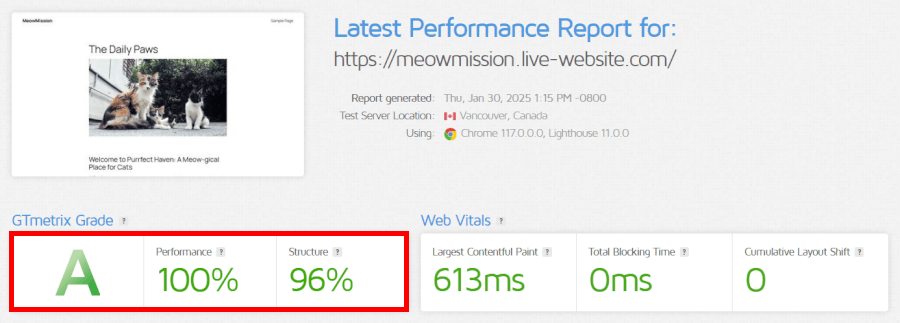
Performance-wise, IONOS delivered solid results. Our test site scored a perfect A (100%) on GTmetrix and averaged fast load times, thanks to SSD storage space and the Cloudflare CDN. During our UptimeRobot monitoring, we experienced zero downtime, which lines up with their 99.9% uptime guarantee. We did run into some mixed results using IONOS’s internal site checker, but nothing that affected our live performance.
Is IONOS the right choice for you?
If you’re looking for affordable hosting with solid performance and a beginner-friendly interface, IONOS is a top contender. It’s ideal for solo creators, small businesses, and anyone who wants a feature-rich hosting experience without the steep learning curve (or price tag). Just be mindful of the renewal pricing and the limited features on entry-level plans.
Bottom line? IONOS delivers great value, especially in the first year. Whether you’re launching a blog, portfolio, or e-commerce site, this host makes it easy to get online — and stay there.
WordPress hosts as recommended by WordPress.org: Here’s our take!
You’ve seen our top WordPress hosting picks, but now it’s time to check out the WordPress hosting providers that WordPress itself recommends. These are the web hosting companies featured on WordPress.org’s official list — trusted to keep your site running smoothly and securely. But which one’s the best match for your needs? Let’s explore!
1. Pressable: Solid support and uptime
Pressable is a managed WordPress web hosting provider created by the same folks behind WordPress.com (Automattic). It’s tailored more for businesses and agencies, and it shows — the platform delivers excellent uptime and speed, along with built-in performance tools such as caching and a web application firewall.
Pressable also shines with its white-glove support and automatic WordPress updates, which help take the stress out of site management. That said, the plans are on the pricier side, so it might be overkill if you're just starting out or working with a tight budget.
2. Bluehost: A classic pick that still delivers
Bluehost has been officially recommended by WordPress.org since way back in 2006, and it’s easy to see why. It combines rock-solid reliability (99.99% uptime), a super simple one-click WordPress install, and 24/7 support via chat or phone — all in a beginner-friendly package.
You also get a free domain for the first year, free SSL, and access to a tidy custom dashboard that makes managing your WordPress site surprisingly smooth. Whether you’re building your first blog or a growing business site, Bluehost is a dependable, no-fuss option — and the value it offers at entry-level pricing is hard to beat.
3. Hostinger: Our favorite for beginners and budgets
If we had to choose one WordPress host for most people, we’d pick Hostinger. It’s not just affordable — it’s shockingly good for the price. Starting at just a few dollars a month, Hostinger gives you an optimized WordPress experience with LiteSpeed servers, built-in caching, and a modern control panel that’s way easier to use than cPanel.
Their onboarding is one of the best we’ve seen, with step-by-step guidance and even an AI-powered website builder if you’re in a rush to get online. It's perfect for beginners exploring their first website builder, but the performance and tools are strong enough to support growing traffic too. Add in a responsive customer team and regular updates, and you’ve got a host that punches well above its price tag.
Find your perfect WordPress hosting fit and go live
Finding the perfect WordPress hosting for your site is a crucial step toward online success, and luckily, you have plenty of great options to choose from.
After diving into the top picks from both us and WordPress.org, it’s clear that Hostinger and Bluehost are the real winners here. Whether you're after affordable pricing, smooth performance, or excellent staff, these two are the ultimate all-rounders. Hostinger shines with its budget-friendly plans and beginner-friendly setup, while Bluehost brings solid reliability and a WordPress-centric experience that's hard to beat.
Meanwhile, IONOS offers a global reach with its fast servers and robust security features, while DreamHost brings excellent value with its generous storage options and stellar customer service. If you’re after a performance boost, SiteGround delivers speedy loading times and top-notch support that’ll keep your site running smoothly, no matter what.
Your ideal WordPress hosting is all about your goals — whether that’s saving money, getting top-notch support, or growing big. With our picks, you’ll be set to launch your site in no time!
Best WordPress Hosting FAQs
How do I host a WordPress website?
First, choose a web host that supports WordPress, like Hostinger or Bluehost. Sign up for a hosting plan, then use the one-click WordPress installation feature provided by your host. Once installed, you can start customizing your site using themes and plugins directly from your WordPress dashboard.
Is managed WordPress hosting worth the extra cost?
It can be worth the extra cost if you prefer a hassle-free experience. It offers automatic updates, enhanced security, and expert support, allowing you to focus on creating content rather than managing technical aspects. It's ideal for businesses or anyone who wants peace of mind and top-notch performance without the tech headaches.
What is the best hosting for WordPress beginners?
For WordPress beginners, Hostinger and Bluehost are excellent choices. They offer budget-friendly plans with user-friendly interfaces, making it easy to get started. Both provide one-click WordPress installation and great customer support, ensuring you have all the help you need as you build your site.
Does WordPress provide hosting services?
Yes, WordPress offers hosting services through WordPress.com. It's a convenient option for those who want an all-in-one package, including hosting, but it has limitations compared to self-hosted WordPress.org solutions. With WordPress.org, you choose your own hosting provider and have more control over your site's features and functionality.
WordPress.com vs WordPress.org: What's the difference?
WordPress.com is a hosted platform where the WordPress software is managed for you — great for getting started quickly, but with limited customization. On the other hand, WordPress.org lets you self-host the content management system (CMS), giving you full control over your site along with access to thousands of plugins and themes. Go with WordPress.com for simplicity, or choose WordPress.org if you want the flexibility and power to shape your site exactly how you like.
Managed vs unmanaged hosting: Which is better for your WordPress site?
Managed hosting is great if you want someone else to handle updates, security, and backups. It's perfect for those who want to focus on content without worrying about technical details. Unmanaged hosting is usually cheaper and gives you more control, but you'll need to manage everything yourself. Choose based on your comfort level with tech tasks and your site's needs.
This guide on the best WordPress hosting services was last updated on April 14, 2025.

Leave a Reply